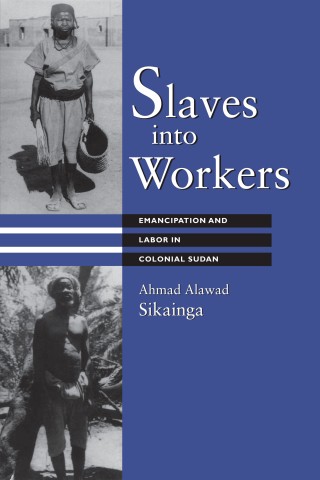Slaves into Workers
For those interested in the history of slavery in contexts other than the trans-Atlantic slave trade, Ahmad Alawad Sikainga's "Slaves into Workers: Emancipation and Labor in Colonial Sudan" (1996) provides a detailed account of the rise and demise of slavery within the Sudan. "In the broadest sense", Ahmad writes, "this book examines slave emancipation and the development of wage labor in the Sudan under British colonial rule. At the specific level, the study focuses on the fate of ex-slaves and other dislocated people in Khartoum, the Sudanese capital, and on the attempt of the colonial state to transform them into wage laborers" (p. xi).
This historical study shows how changes in the pre-colonial period transformed slavery from being limited to the elite to a common practice. The shifts included changes related to "taxation, commerce, military recruitment, and land tenure" (p. 35), throughout showing that there was "a strong link between slave emancipation, ethnicity, and labor" (p. 185) during the pre-colonial and colonial periods. With colonization, the "colonial economy guaranteed the continuation of slavery" (p. 39) through the types of projects its prioritized and funded, particularly in the agriculture sector. The international community would later put pressure on the colonial government to address slavery, including "continuous pressure from the League of Nations and the Anti-Slavery Society" (p. 102) resulting in moves to "suppress rampant slave trading and arms smuggling" (p. 103) toward the end of the 1920s.
"Although institutionalized servitude existed in the Sudan since antiquity, the widespread use of slaves did not occur until the end of the eighteenth and beginning of the nineteenth century when Turco-Egyptian encroachment was set in motion. These changes included commercial contact with the outside world, the rise of a middle class, and the development of a new ideology that justified domination and enslavement" (p. 184).
On the gendered nature of slavery, this book provides a wealth of insight. During the colonial regime, the author writes that while "male slaves had to grapple with the antipathy of the government officials and the resistance of their owners [to emancipation], slave women faced even greater obstacles to emancipation… According to official estimates, they [females] constituted three-fourths of the slave population in the Sudan at the beginning of this century. Moreover, acquisition of female slaves continued during the first twenty years of this century. As male slaves began to leave, the labor of slave women became even more vital and owners made every possible effort to prevent their manumission." (p. 54)
The book is quite formulaic in style, but offers a depth of historical research that makes it an excellent reference on the topic.
